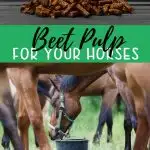If you own a horse, there is a good chance that you have heard about beet pulp. You have probably even questioned if you should add it to your feeding program. There are a number of misleading claims out there about the dangers of beet pulp. The truth is beet pulp is safe for horses and it can be very beneficial to your horse’s health.
Beet pulp is the product that remains after the sugar and moisture is pressed out of sugar beets. It is highly digestible, low in sugar and high in fiber. It can serve as a supplemental source of forage for horses and is a great choice for horses that struggle to maintain their weight.
There are a lot of different ideas about the right way to feed beet pulp to your horse. Some people even claim that it is dangerous. You can use the following information to separate the myths from reality and decide whether beet pulp is right for you and your horse.
Table of Contents
Nutritional Value of Beet Pulp
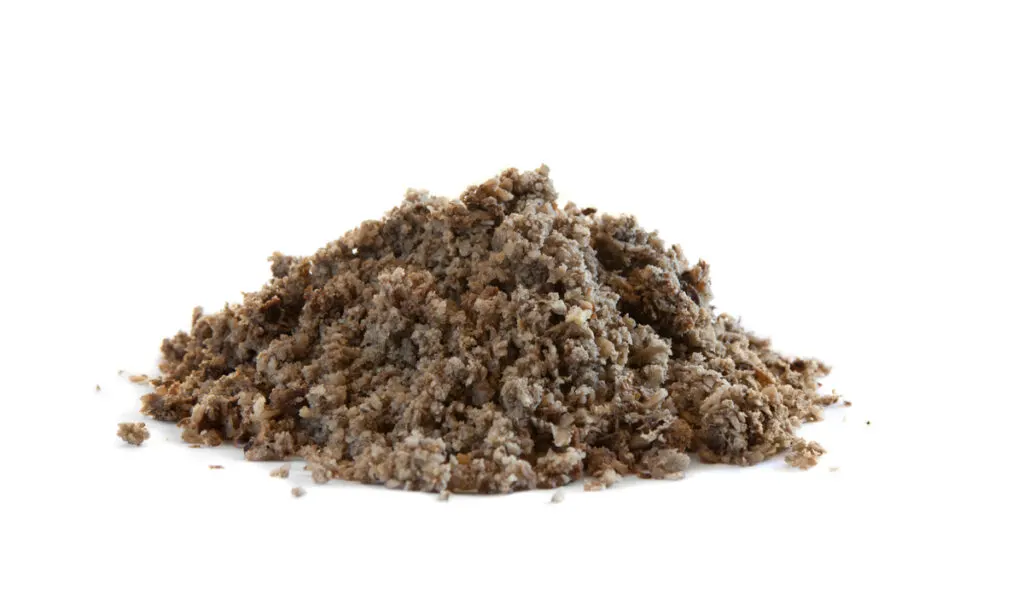
Beet pulp is low in sugar which makes it easier for horses to digest. It is also high in fiber, making it a type of forage for horses.
Forage is a bulky food that aids in gut health and is vital for horses. Beet pulp is a high caloric source of energy and has a higher digestible energy count than hay. Since horses can digest beet pulp easier than hay, they have room to eat more food.
This increases their calorie intake and this means that beet pulp can help add weight to horses that have a hard time gaining it. This makes it a great choice for senior horses and hard keepers.
Beet pulp is high in calcium, but keep in mind that it does not contain a lot of vitamins or minerals. It is not a substitute for your horse’s main diet and you should not use it to replace grain. You can, however, use beet pulp to replace a percentage of the hay in your horse’s diet. Since the product is low in sugar, it can be safely fed to horses that suffer from insulin disorders.
The exact nutritional value of beet pulp can vary from manufacturer to manufacturer but, it typically contains at least 7.5% Crude Protein, 0.5% Crude Fat, and a Maximum of 21% Crude Fiber (source).
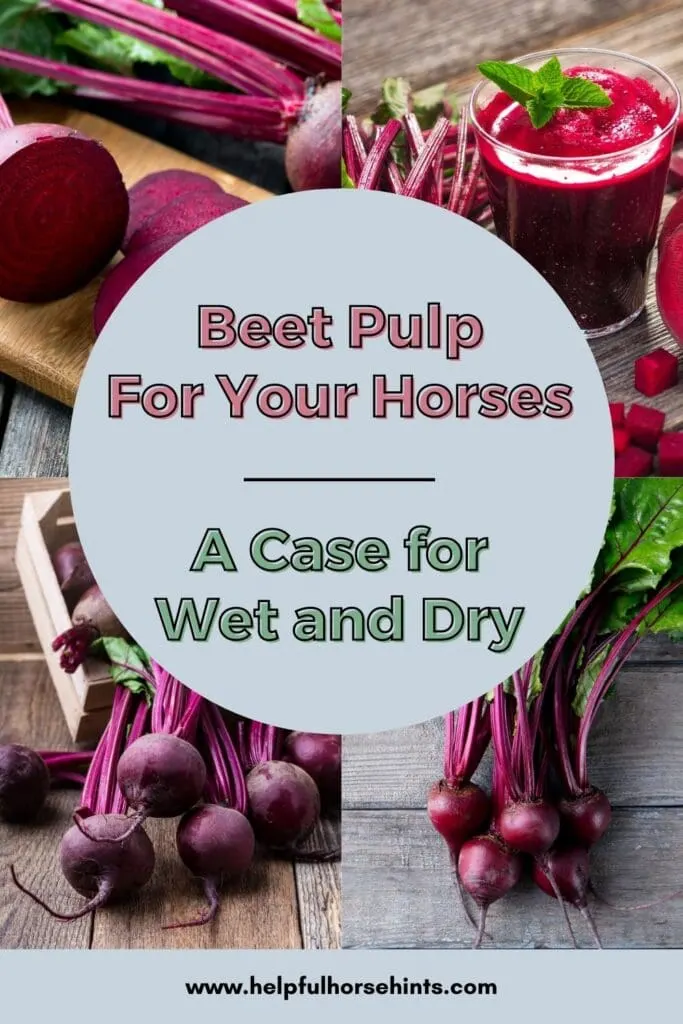
Dry Beet Pulp vs. Wet Beet Pulp and the Argument for Both
You can either feed beet pulp dry or soak it in water before you feed it to your horse. Both ways are acceptable, however, most horse owners prefer one method over the other. Those that feed beet pulp straight from the bag, with no prep, are feeding it dry.
Proponents of using dry beet pulp often mix it with their horse’s regular grain. They may feed it separate from the grain if their horse likes it unmixed. People who prefer feeding this product dry often consider the thought of soaking beet pulp to be a waste of time. They also know that it could lead to other issues if the wet beet pulp is left out too long in hot temperatures. Feeding beet pulp dry is just what works best for them and their horse.
Many equestrians do prefer to feed wet beet pulp instead of dry. This means that they soak it in water for a specific amount of time before they feed it. This allows the beet pulp to hydrate and expand in size. For many horses, it is easier for them to eat the water-soaked beet pulp. They prefer the texture of it over the dry and the water makes it more palatable.
Many horses find it easier to swallow this way. A horse that has dental issues will be able to chew the wet beet pulp much easier than the dry.
Feeding wet beet pulp is a better choice if you have a horse that struggles to stay hydrated. You can add extra moisture and make a really sloppy beet pulp mash/slurry. This is especially helpful during the hot days of summer as well as the cold days of winter. Hydration is important and adding water to beet pulp is just one way to encourage water intake.
Overall though, it does not matter whether you choose to feed wet or dry beet pulp as both methods of feeding are suitable for horses.
Beet Pulp Mythology
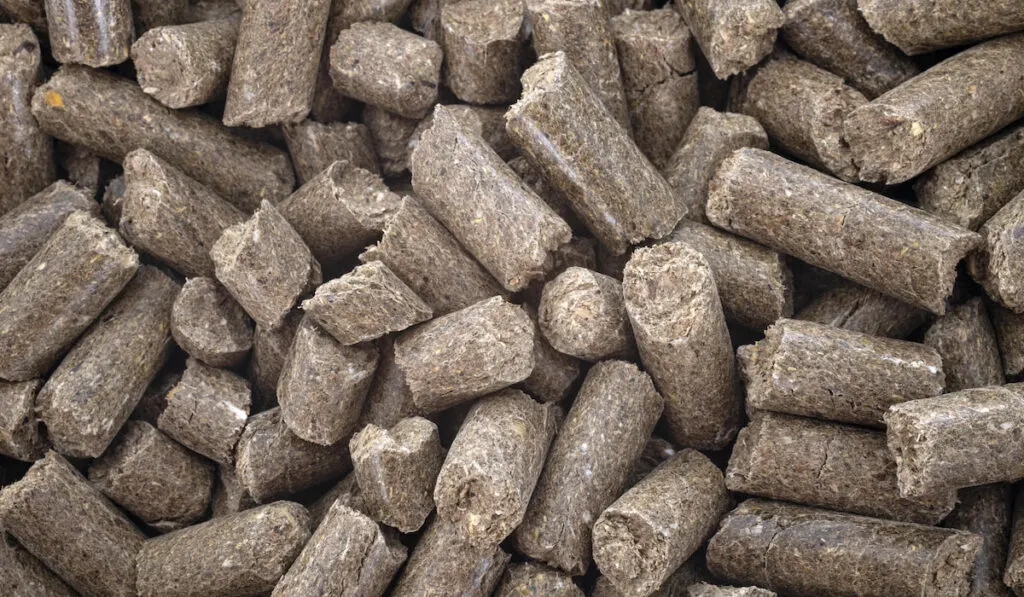
One common myth about feeding dry beet pulp to horses is that it can cause them to choke. Dry beet pulp does not cause a horse to choke. If your horse is prone to choking on its regular grain, it will also do the same with dry beet pulp.
In fact, according to the American Association of Equine Practitioners (AAEP):
Contrary to popular opinion, you don’t have to soak beet pulp in water to feed it safely to horses—studies in which horses were fed dehydrated beet pulp, up to a level of 45 percent of their total diet, noted no ill effects whatsoever. Not only did the horses not “explode” (thus laying that myth to rest!), but they also suffered no signs of colic or choke, nor did the water content in their manure change.
AAEP Website – https://aaep.org/horsehealth/feeding-beet-pulp
A horse that eats grain too fast will eat beet pulp too fast as well. It is also rumored that it can cause colic or stomach ruptures when the dry pulp expands in a horse’s digestive system. This is simply not true. Any horse that eats a massive amount of food at one time has the potential to colic. If your horse accidentally eats a massive amount of beet pulp at one time, then it is definitely possible for them to colic on it.
How to Use Beet Pulp
How Much Beet Pulp Should You Feed?
Beet pulp is not meant to be a grain replacement for horses. It is a forage supplement that serves as an extra caloric food source. Your horse’s normal hay ration should be at least 2 percent of their body weight. If you want to add beet pulp as a hay supplement, you should only replace 25% of your horse’s daily hay intake.
If your horse weighs 1100 pounds, you could feed 15 pounds of hay and 5 pounds of beet pulp. If your horse is underweight, you can even increase the beet pulp ration to 50%, but no more than that. In that scenario, you would feed 10 pounds of hay and 10 pounds of beet pulp to an 1100 pound horse.
If you plan on soaking your beet pulp in water, make sure that you measure it while it is still dry. The weight will vary after it has absorbed water, making weighing it wet pointless. Beet pulp cannot be used to completely replace hay intake. Your horse still will need to be fed hay or other forage even if you add beet pulp to their daily diet.
As with any new food, it is always advised to start with small portions and slowly increase the amount over time until you reach the desired daily feeding amount. This helps to prevent issues such as colic.
Pellets vs Loose Beet Pulp
When you go to the store to buy your beet pulp, you will find that it comes in two different varieties, pelleted and loose. The pelleted form is pressed by a machine, dried out and then compressed into pellets. Beet pulp pellets take a lot longer to soak than the loose. Many horse owners who have used both varieties prefer the loose beet pulp because it is much easier to manage.
The loose beet pulp has been shredded into small strips, but it is not compressed like pellets. This makes loose beet pulp soak up water faster and it is easier to mix in with grain. Pelleted beet pulp may typically cost less than loose, but the higher price is worth the convenience. Many horses often tend to prefer the loose beet pulp over the pelleted.
On the opposite side, loose beet pulp is a real pain to scoop. If you need to feed multiple horses quickly pelleted beet pulp will scoop easily much like any other feed. Just keep in mind that if you are soaking the pellets, you will need to give them extra time to absorb the water. This will happen more quickly in the summer when it is warm. You can also use warm or hot water to speed up the process.
My personal preference is for pelleted beet pulp because of the ease in which it scoops. My routine is to scoop the beet pulp into the bucket as soon as I go out to play with my horses. By the time I am done, the beet pulp is usually ready to go and I can add in the rest of the grain, if any, and feed before I go.
When feeding multiple horses, I’ll often just make a big bucket of it and then dish out individual rations at feeding time.
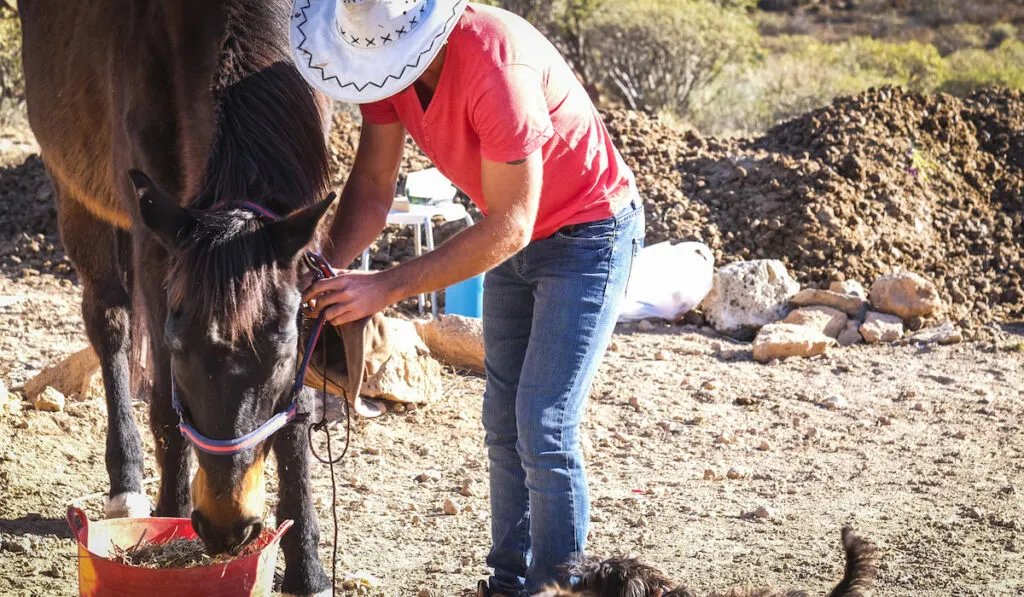
Crafting the Perfect Wet Beet Pulp Recipe
There are a lot of recipes for soaking beet pulp. Every horse owner and veterinarian has their own method that works for them. It may take some trial and error, but it won’t take long to find what works best for you and your horse.
Deciding your beet pulp-to-water ratio is the first trick. If you want to feed slightly moistened beet pulp, you can mix a 1:1 ratio. If you want a wetter product, you can mix 1 part dry beet pulp to 2 parts water. If that is not enough, you can increase the water until you reach the desired moisture content.
Once you add your water, you need to cover the container with something to keep flies and bugs out. The next step is determining how long you need to let your mixture soak. The amount of time needed will depend on which type of beet pulp you have chosen, the temperature of your water and the temperature outside. It can take anywhere from 30 min to an hour on the low side.
Some people will allow the beet pulp mixture to sit for a few hours, however, it should never be left soaking in a warm environment. This could cause it to spoil too quickly. The best way to tell if your mixture is done is to see if the water has been completely absorbed by the beet pulp. Your mixture will be fluffy and wet, completely unlike it was when you started.
Remember that since you can feed beet pulp wet or dry, for most horses, it’s OK to feed it partially soaked if you are in a hurry.
Should You Rinse/Drain Beet Pulp Before Feeding It?
For the most part, you don’t have to rinse your beet pulp before you feed it. If you happen to have a horse that suffers from insulin resistance or other sugar influencing diseases, you can rinse and drain the beet pulp before feeding it. This can be done to dry or soaked beet pulp to remove any of the small amount of sugar that remains in the product.
Does Beet Pulp Go Bad?
Beet pulp can definitely go bad. Soaked beet pulp will only be good for up to 24 hours if you store it covered and in a cool environment. You cannot leave it out in the heat for too long or it will spoil. Always check any beet pulp that you have soaked before you feed it to your horse. If it smells moldy or has a fermented smell to it, throw it out. It should not be fed if it is bad. Opened bags of beet pulp can go bad if moisture gets into them, especially if it is hot outside. It is best to store any opened, dry beet pulp in a cool and moisture-free environment to prevent molding.
Beet pulp is a quality source of forage for horses and it can even help stretch your hay when you are running low. It can add weight to horses that need a little extra boost and it is perfect for horses with insulin-related issues. If it is prepared and fed correctly, beet pulp can be an excellent addition to your feeding program.
Related Posts
- Easy Enrichment Ideas for the Bored Horse
- 15 Fruits and Vegetables Horses Love to Eat
- Tips for Feeding Your Horse Only Once Per Day

